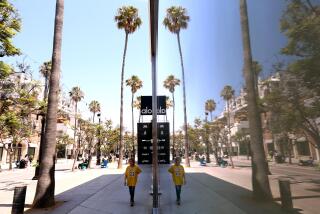Abbot Kinney Boulevard’s renaissance a mixed blessing

Pride over what GQ magazine called “the Coolest Block in America” has turned to anxiety for some longtime merchants and residents who say Abbot Kinney is getting too posh for its pants.
- Share via
When reporters for national magazines and tourists from around the world recently began showing up on Abbot Kinney Boulevard, veteran shopkeepers saw the attention as validation that they had turned the once-desolate stretch into a hip strip.
Now, however, that pride over what GQ magazine called “the Coolest Block in America” has turned to anxiety for some longtime merchants and residents who say Abbot Kinney is getting too posh for its pants. The arty, indie fare that used to dominate the boulevard is being replaced by $1,400 handbags and $600 boots from Italy.
Developers have bought and razed or renovated Abbot Kinney buildings, including vintage bungalows that had housed holdouts from the street’s rougher days. Rents for some storefronts have doubled or tripled, and retailers and cafe owners have hired valet companies to ease the parking crunch.
Modish chain stores with distressed-wood floors and subdued lighting have replaced pioneering shops such as Surfing Cowboys and Jin Patisserie, which have relocated to more affordable digs in Mar Vista and Culver City or are eyeing emergent Rose Avenue in Venice.
The wildly successful bistro Gjelina — no substitutions, even for you, Robert Downey Jr. (who owns a Modernist house up the street) — is building another eatery on the boulevard and a bakery nearby. Arnold Schwarzenegger wants to turn the former Broadway Gymnastics building at the corner of Main Street into his office and a small restaurant. And local developers have proposed a boutique hotel that would incorporate Joe’s and Primitivo restaurants.
An upgrade was inevitable, given the street’s location and the area’s favorably evolving demographics, including the arrival of Google and other Silicon Beach companies.
“But now,” said Los Angeles Councilman Mike Bonin, who lives in neighboring Mar Vista, “it may be at risk of being a victim of its own success.”
Some sense in the offing a replay of familiar flame-outs such as once hot and now not so much Melrose and Montana avenues.
“More and more every day, it feels like Abbot Kinney is separating itself from the neighborhood,” said Marta Evry, a longtime resident. “It’s a street for tourists, people from outside the area, but not a street for the people who live here.”
::
Three decades ago, Abbot Kinney was an enclave where struggling artists coexisted uneasily with violent gang members.
Back then, when the not-quite-mile-long stretch between Venice Boulevard and Main Street was known as West Washington Boulevard, gunshots routinely rang out at night in the Oakwood, the adjoining drug-infested ghetto. A U.S. senator’s niece was shot to death in a holdup on the sidewalk in 1980.
Abbot Kinney had been on a slow upward trajectory since a name change to honor the coastal community’s visionary founder. A crackdown on gang activity helped rid the area of career criminals. Meanwhile, singular haunts such as Hal’s Bar & Grill and relative newcomers such as Gjelina drew crowds.
Outsiders began to view the street as a great real estate investment. New owners revamped buildings that in some cases had stood untouched for decades. Real estate agents now use proximity to Abbot Kinney as a selling point for $2-million cottages in, yes, the Oakwood, now largely gentrified.
The shift is happening before bemused residents’ eyes. “Day by day, it’s changing,” said Laddie John Dill, an artist who has lived and worked near the boulevard for decades. “I’d hate to see Abbot Kinney lose its uniqueness and become like a mall.”
Young artists, who in the past lent flavor to the street, would have to be trust-fund babies to afford space on Abbot Kinney now, Dill said.
It was just six years ago that Pinkberry, the frozen yogurt chain, opened an outlet on Abbot Kinney and was greeted with the modern equivalent of torches and pitchforks. A group called Venice Unchained, dedicated to keeping large-scale chain stores off the boulevard, organized protests and boycotts. The shop closed three years later because of disappointing sales.
Now, a dozen or more chains — including Lucky Brand, Gant, Flannel and Alexis Bittar — populate the street. They’re not the Gap or H&M, admittedly, but neither are they mom-and-pop operations.
“It’s gotten really fashionable, not always in a good way,” said Pierre Auroux, a Venice resident who was leaving an Abbot Kinney lunch spot on his bicycle one recent sunny afternoon. In years past, he added, “it was less Beverly Hills and more of a beach vibe. It wasn’t as safe and nice, but that’s what gave it character.” The people-watching, however, can be excellent. Recent sightings: Ben Affleck and Sky Ferreira.
The Abbot Kinney buzz has carried far and wide. Visitors from New York, Europe, Asia and Australia have put the street on their itineraries. “The appeal of Venice is broadening, and Abbot Kinney is at the epicenter,” said Jack V. Hoffmann, a property owner and longtime resident.
Kristy Choo was a new immigrant from Singapore in 2003 when she opened Jin Patisserie, featuring pastries and a tea garden. She initially paid rent of $3,000 a month. Over time, her rent doubled, but she could manage. Then early this year, her landlord said he wanted $40,000 a month. She told him: “No way.” She moved to Culver City and is selling mostly wholesale. Kreation Kafe & Juicery, a chain franchise, filled her spot on Abbot Kinney.
Hal’s opened 27 years ago when Abbot Kinney “was like a war zone,” said Donald Novack, co-owner. Early on, his wife, Linda, had to step over a dead body at the restaurant’s back door. “Back then, we were looking for somebody to park on the street. Now it’s totally opposite.”
::
One person pleased with the renaissance is Stephen Vitalich, an architect who has revamped many buildings on the street. “On the whole, the street is changing for the good,” he said. “If some merchants get pushed out because they can’t compete … that’s capitalism.”
Don Glunts, a real estate investor, said the upswing has been long in coming. He closed escrow on an Abbot Kinney building in 1980 and was celebrating there with a group of friends the night Sarai Ribicoff, niece of Connecticut Sen. Abraham Ribicoff, was shot just outside. So inured were people to gunfire, Glunts said, they didn’t even go outside to see what had happened. Until recently, he said, “It was never really a robust street.” He and his partners have leased a space to Scotch & Soda, an Amsterdam-based clothier. “They are all over Europe and wanted to come into the coolest, hippest streets in the U.S.,” Glunts said.
The biggest test for the street looms as developers push for approval of a nearly 70-room hotel. (They backed off plans for 92 rooms and a fourth story after opponents protested.) If the plans are approved and the restaurants attempt to stay open during construction, chefs will be nervously watching for dust in the tomato bisque.
The changes have already proved too much for Carol Tantau, owner of Just Tantau, an eclectic jewelry store that has been a boulevard mainstay since 1982.
“We’ve been up and coming for 20 years,” Tantau, who lives in her store, said of Abbot Kinney. Yet many of her veteran customers have stopped coming to the street because of the altered atmosphere and scarce parking. Tantau plans to move come January but knows it will be difficult to replicate the current arrangement. “Where can I go,” she said, “with two cats and a Steinway grand?”
A map of Abbot Kinney businesses is at the boulevard merchants’ website.
More to Read
Sign up for Essential California
The most important California stories and recommendations in your inbox every morning.
You may occasionally receive promotional content from the Los Angeles Times.











